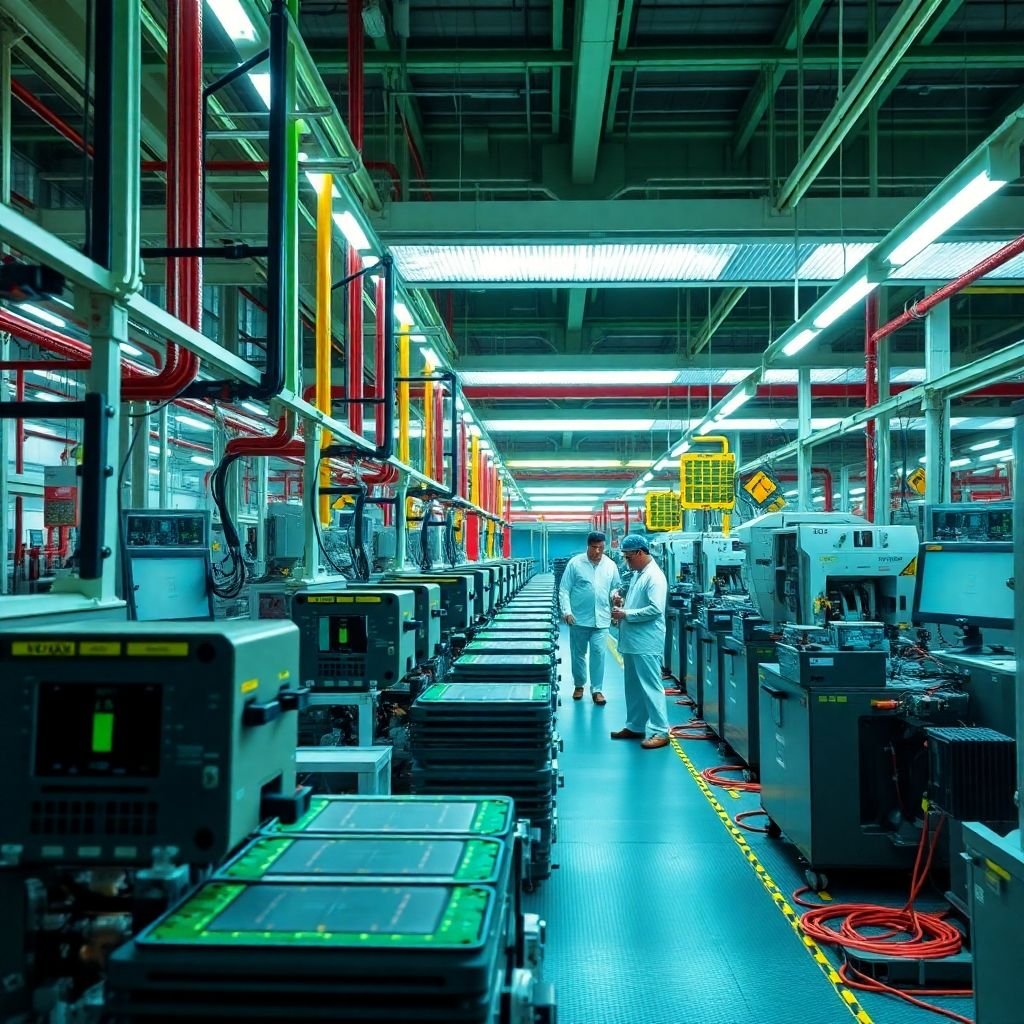Nvidia’s recent announcement to invest billions in US chip production marks a significant turning point for the tech landscape. With plans to pour hundreds of billions into domestic manufacturing over the next four years, Nvidia aims to strengthen its supply chain and bolster US technological independence. This move comes at a time when geopolitical tensions and supply chain vulnerabilities have prompted many companies to reconsider their global strategies. Let’s explore the implications of Nvidia’s investment and what it means for the future of the semiconductor industry.
Key Takeaways
- Nvidia is set to invest hundreds of billions in US chip production over four years.
- The investment aims to mitigate supply chain risks and enhance US technological sovereignty.
- Nvidia’s move could reshape global semiconductor supply chains and market dynamics.
- This investment is expected to create numerous jobs and stimulate local economies.
- Collaborations with companies like TSMC and Foxconn will play a crucial role in Nvidia’s manufacturing plans.
Nvidia’s Strategic Shift Towards Domestic Manufacturing

Nvidia’s decision to pump hundreds of billions into US manufacturing marks a pretty big change. It’s not just about making more chips; it’s a strategic move to secure their supply chain and align with the US government’s push for more domestic tech production. This could really shake things up for the whole industry.
Understanding the Rationale Behind the Investment
So, why is Nvidia doing this now? Well, a big part of it is about risk management. They want more control over where their chips come from. It’s also about tapping into the growing capabilities of US-based manufacturing. Jensen Huang mentioned the feasibility of this investment, citing advancements in US manufacturing and strong partnerships with key suppliers like TSMC and Foxconn.
The Role of Geopolitical Tensions
Geopolitics plays a massive role. With tensions rising in certain parts of the world, especially around Taiwan, Nvidia wants to reduce its reliance on overseas manufacturing. The company’s decision to shift its supply chain back from Asia highlights the importance of geopolitical stability in the semiconductor industry. It’s a smart move to protect their interests in an uncertain world. This could influence other tech giants to consider similar strategies to mitigate geopolitical risks.
Aligning with US Manufacturing Policies
It’s no secret that the US government is keen to bring more manufacturing back home. Nvidia’s investment fits perfectly with this agenda. By investing in US-based production, they’re not only securing their supply chain but also getting on the right side of policymakers. The shift toward a more protectionist stance led many tech companies to reconsider their global supply chains. This could mean more incentives and support from the government in the long run.
Nvidia’s investment in US manufacturing is a strategic move that aligns with its long-term goals of diversifying its supply chain and reducing reliance on overseas manufacturing. This investment is expected to enhance supply chain resilience and bolster the company’s operational landscape.
Implications for the Semiconductor Industry

Potential to Reshape Global Supply Chains
Nvidia’s move to invest heavily in US chip production could really shake things up for the semiconductor industry. For years, Taiwan has been the dominant player, but this investment might start to shift the balance. It’s not just about business; it touches on national security and global trade. This could lead to a more distributed and potentially more resilient supply chain, reducing reliance on single regions. It’s a big deal for everyone involved.
Impact on Competitors and Market Dynamics
Nvidia’s investment puts pressure on other big players. Companies like Intel and AMD will need to step up their game to compete. It could spark a new wave of innovation as everyone tries to gain an edge. The market dynamics are definitely going to change, and we might see some interesting partnerships and acquisitions as companies try to position themselves. Nvidia is keeping a close eye on Intel’s capabilities and may consider using its services in the future. This investment could attract other tech companies to follow suit, leading to increased investment in the US semiconductor industry and job creation. The US semiconductor industry is about to get a whole lot more interesting.
Strengthening US Technological Sovereignty
This move is about more than just making chips; it’s about the US taking control of its technological future. By bringing chip production back home, the US can reduce its dependence on foreign countries and protect its intellectual property. It’s a strategic move that could have long-term benefits for the US economy and national security. As countries compete to lead in AI, automation, and 5G, controlling chip production will be a huge advantage.
Building chip factories in the US is more expensive than in Asia, where labour and materials are cheaper. The US needs more trained workers in semiconductor manufacturing, which could slow down production. Constructing advanced chip plants takes years, meaning the full benefits won’t be seen right away.
Economic Benefits of Nvidia’s Investment

Nvidia’s decision to pump billions into US chip production isn’t just about tech; it’s a potential economic goldmine. The move is expected to have a significant impact, rippling through various sectors and creating opportunities. It’s not just about Nvidia’s bottom line; it’s about boosting the US economy as a whole. This is a big deal, and here’s why:
Job Creation in the Tech Sector
One of the most immediate benefits will be the creation of jobs. We’re not just talking about a few positions; we’re talking about a substantial increase in employment opportunities across the tech sector. From engineers and technicians to manufacturing staff and researchers, Nvidia’s investment will lead to a surge in demand for skilled workers. This is a chance to procure electronics and boost the economy.
- Manufacturing jobs
- Engineering roles
- Research positions
Stimulating Local Economies
Beyond job creation, Nvidia’s investment will act as a catalyst for local economies. The presence of a major chip manufacturer can attract other businesses, leading to the development of tech clusters and innovation hubs. This can revitalise communities and create a more vibrant economic landscape. It’s about more than just Nvidia; it’s about the ecosystem that grows around it.
The influx of capital and expertise will stimulate growth in related industries, such as equipment suppliers, software developers, and service providers. This creates a multiplier effect, where the initial investment generates even greater economic activity.
Attracting Further Investments
Nvidia’s commitment to US manufacturing sends a powerful signal to other tech companies and investors. It demonstrates that the US is a viable and attractive location for high-tech manufacturing. This can encourage further investments in the semiconductor industry and other advanced technology sectors. It’s about creating a positive feedback loop, where one investment leads to another, and another. This could lead to quantum computing research and development.
- Increased investor confidence
- Attraction of foreign direct investment
- Growth of related industries
Nvidia’s investment is expected to create a ripple effect, attracting further investments and stimulating economic growth. This is a game-changer for the US tech industry and the economy as a whole. The potential is huge, and the benefits could be felt for years to come.
Collaborations with Key Industry Players

Nvidia’s ambitious plan to ramp up US chip production isn’t a solo mission. It hinges significantly on forging and maintaining strong collaborations with key players in the semiconductor world. These partnerships are vital for accessing expertise, resources, and established manufacturing capabilities.
Partnerships with TSMC and Foxconn
Nvidia’s relationships with TSMC and Foxconn are particularly important. TSMC, a leading global chip manufacturer, is already expanding its operations in the US, including a substantial investment in Arizona. This expansion aligns perfectly with Nvidia’s goals, potentially providing access to cutting-edge manufacturing processes and capacity. Foxconn, known for its electronics manufacturing prowess, could play a role in assembling and packaging Nvidia’s chips. The TSMC partnership has broader geopolitical implications.
Leveraging Existing Relationships
Nvidia isn’t starting from scratch. It has cultivated relationships with numerous suppliers, technology providers, and research institutions over the years. These existing connections provide a solid foundation for building a robust US-based manufacturing ecosystem. For example, Nvidia’s work with ASML, a key supplier of lithography equipment, is crucial for advanced chip production. These relationships are not just about transactions; they’re about shared knowledge, innovation, and mutual success.
Future Collaborations in Quantum Computing
Looking ahead, Nvidia is likely to seek collaborations in emerging fields like quantum computing. As quantum technology matures, partnerships with quantum computing companies and research labs will be essential for developing specialised chips and hardware. This could involve collaborations on novel materials, architectures, and manufacturing techniques. The company’s investment in US manufacturing is likely to intensify competition for other tech giants like Intel and AMD.
Nvidia’s success in US chip production will depend not only on its own investments but also on its ability to build and nurture a strong network of collaborators. This collaborative approach is essential for overcoming technical challenges, accessing resources, and driving innovation in the semiconductor industry.
Here are some key areas where collaboration will be vital:
- Advanced manufacturing processes
- Materials research and development
- Supply chain management
- Workforce training and development
Nvidia’s Vision for Future Chip Production
Establishing a Robust Manufacturing Ecosystem
Nvidia’s vision extends beyond simply building chip factories; it’s about creating a whole ecosystem in the US. This involves bringing together different companies, research institutions, and skilled workers to make sure the US can design, manufacture, and test advanced chips. It’s a big undertaking, but Nvidia seems serious about making it happen. They’re talking about new production lines and expanding partnerships with companies already in the game.
Innovations in Semiconductor Technology
Nvidia isn’t just interested in making chips the way they’ve always been made. They’re looking at new technologies and ways to improve the process. This could mean:
- New materials for chips
- More efficient manufacturing techniques
- Better ways to design chips for specific tasks
This focus on innovation is key to staying ahead in the semiconductor industry. If Nvidia can develop new technologies, it will have a big advantage over its competitors. It’s a long game, but the potential rewards are huge.
Focus on AI and Data Centre Hardware
Nvidia’s main focus is on chips for AI and data centres. These are the chips that power things like self-driving cars, cloud computing, and advanced research. US-made chips are critical for these applications. They see a huge demand for these chips in the future, and they want to be the ones making them. This means:
- Investing in new chip designs specifically for AI
- Building factories that can produce these advanced chips
- Working with data centre companies to understand their needs
They’re not just thinking about today’s technology; they’re looking ahead to what’s coming next. This forward-thinking approach is what sets Nvidia apart. They are also planning to open a quantum computing research lab to further their research.
Challenges Ahead for Nvidia’s Manufacturing Plans
Nvidia’s ambitious plan to ramp up chip production in the US isn’t without its hurdles. While the move promises significant benefits, several challenges could impact the timeline and overall success of the project. These challenges range from regulatory complexities to intense competition within the tech industry.
Navigating Regulatory Hurdles
Setting up new manufacturing facilities in the US involves a complex web of regulations. These include environmental permits, labour laws, and compliance with various federal and state guidelines. Delays in obtaining necessary approvals could significantly slow down Nvidia’s expansion plans. It’s not just about getting the green light; it’s about navigating the ongoing compliance requirements, which can be resource-intensive. The US export controls are also a factor.
Addressing Supply Chain Vulnerabilities
While the goal is to reduce reliance on overseas suppliers, establishing a fully self-sufficient supply chain in the US is a monumental task. Nvidia will still need to source raw materials and specialised equipment from various global suppliers. Any disruptions in these supply chains, whether due to geopolitical events or natural disasters, could impact production. Consider these points:
- Reliance on specific suppliers for critical components.
- Potential for increased costs due to tariffs or trade restrictions.
- Logistical challenges in transporting materials and equipment.
Competition from Other Tech Giants
Nvidia isn’t the only tech company looking to expand its manufacturing presence in the US. Intel, TSMC, and other major players are also investing heavily in domestic production. This increased competition could lead to:
- A shortage of skilled workers.
- Increased costs for land and resources.
- Potential for price wars and reduced profit margins.
Successfully overcoming these challenges will be crucial for Nvidia to achieve its vision of establishing a robust and competitive chip manufacturing ecosystem in the US. It requires careful planning, strategic partnerships, and a proactive approach to mitigating potential risks.
The Broader Impact on US Tech Innovation
Encouraging a New Wave of Tech Startups
Nvidia’s investment could act as a catalyst for new tech startups. The presence of a major player like Nvidia in US chip production boosts American tech innovation, creating opportunities for smaller companies to develop complementary technologies and services. This could lead to a more vibrant and competitive tech ecosystem, with increased innovation and job creation. It’s not just about the big players; it’s about nurturing the next generation of tech leaders.
Enhancing Research and Development
With increased domestic chip production, there’s a greater incentive for research and development within the US. Universities and research institutions could benefit from closer collaboration with Nvidia, leading to breakthroughs in semiconductor technology and related fields. This could also attract more talent to the US, further strengthening the country’s position as a global leader in tech innovation.
Fostering a Skilled Workforce
Nvidia’s manufacturing plans will require a skilled workforce, creating a demand for engineers, technicians, and other specialists. This could lead to increased investment in education and training programmes, ensuring that the US has the talent needed to support the growing semiconductor industry. A skilled workforce is essential for sustaining long-term innovation and competitiveness.
The focus on domestic manufacturing can lead to a virtuous cycle, where increased investment in education and training leads to a more skilled workforce, which in turn attracts more investment and innovation. This can create a positive feedback loop that benefits the entire US tech sector.
Here’s a quick look at the potential impact on workforce development:
- Increased demand for STEM graduates
- More apprenticeships and training programmes
- Greater collaboration between industry and academia
A New Era for US Tech Manufacturing
In summary, Nvidia’s massive investment in US chip production is a significant move that could change the tech landscape. By shifting focus back to domestic manufacturing, Nvidia not only aims to secure its supply chain but also supports the broader goal of revitalising American tech. This could lead to more jobs and innovation in the industry, making the US a key player in the global semiconductor market. As Nvidia takes these steps, it will be interesting to see how other companies respond and whether this trend towards local production continues.
Frequently Asked Questions
Why is Nvidia investing in US chip production?
Nvidia is investing in US chip production to strengthen its supply chain and reduce risks from geopolitical tensions, especially those related to Taiwan.
How much is Nvidia planning to invest?
Nvidia plans to invest hundreds of billions of dollars in US semiconductor and electronics manufacturing over the next four years.
What are the expected benefits of this investment?
This investment is expected to create jobs, boost local economies, and enhance the overall US tech industry.
Who will Nvidia collaborate with for this project?
Nvidia will work with major companies like TSMC and Foxconn to support its manufacturing efforts.
What challenges might Nvidia face in its manufacturing plans?
Nvidia may face challenges such as regulatory issues, supply chain vulnerabilities, and competition from other tech companies.
How could this investment affect the tech industry in the US?
Nvidia’s investment could lead to more tech startups, increased research and development, and a more skilled workforce in the US.









